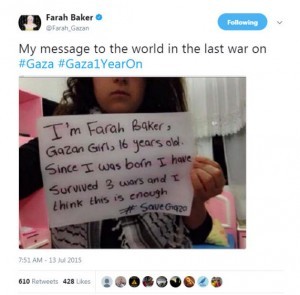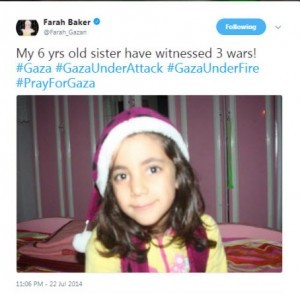Late at night on July 28, 2014, 16-year-old Farah Baker should have been asleep. Instead, the Gaza resident was cowering in fear as flares exploded around her, while sharing her terror in a flurry of tweets. “Flares in the sky all the time,” she tweeted, along with a photo showing a streak of light.
“I AM CRYING AND CAN’T STAND BOMBS SOUND! I’M ABOUT TO LOSE SENSE OF HEARING!” went another.
Later, she tweeted, “I can’t stop crying. I might die tonight.” That missive got over 15,000 retweets, some from journalists around the world.
Thanks to her prolific Twitter feed, Baker became an “influencer,” as her experience of the Israeli bombing of Gaza spread, enticing the media with her story and gaining followers to the Palestinian cause.
As British-Greek journalist David Patrikarakos shares in his new book, “War in 140 Characters: How Social Media is Reshaping Conflict in the Twenty-First Century,” (Basic Books), out now, platforms like Facebook and Twitter have transformed the nature of propaganda and even war itself.
When a nation fights an opposition group, such as Israel vs. Hamas or the US vs. ISIS, the battle is fought on two fronts — on the ground and on social media.
While countries have superior firepower, the underdog status of the opposition groups gives them an advantage in gaining sympathy online, which in turn leads to more global support and even more soldiers and firepower in real life. Given social media’s reach, winning the information war may be even more important then winning the physical one.
“Information operations once supported battlefield operations on the ground. Now, increasingly, battlefield operations support the information operations on TV and in cyberspace,” Patrikarakos tells The Post.
The following three battles from his book examine the phenomenon, showing how social media has changed the nature of 21st century war.
Israel vs. Hamas
Caught in the Israel-Hamas war of 2014, Baker tweeted photos, videos and tales of her life in English, so people in other countries could understand what the Palestinian experienced firsthand.
As the violence grew, so did her number of followers. “She became an increasingly popular source of information coming out of Gaza — as far removed from the centralized and highly bureaucratic newsrooms of The Guardian or The Wall Street Journal as it is possible to be,” Patrikarakos writes. “In just a matter of weeks, Farah said, her followers jumped from 800 to around 200,000.” (Still active, she currently has 180,000.)
Baker excelled at making her tweets personal.
On July 21, 2014, she tweeted a photo of herself holding a handwritten sign in English: “I’m Farah Baker, Gazan girl, 16 years old. Since I was born I have survived 3 wars and I think this is enough #SaveGaza.” It was retweeted more than 2,500 times.
Farah sent hundreds of tweets during the war, creating an online diary of Gazan suffering. The most “powerful and popular element” of her Twitter feed was its candid expression of fear and sadness. One tweet featured a picture of her 6-year-old sister in a Santa Claus hat, with the words, “My 6yrs old sister have witnessed 3 wars! #GazaUnderAttack #GazaUnderFire #PrayForGaza”
The night of July 28, the most ferocious day of the war, made her a Gazan celebrity. As Israel began exploding flares and family and neighbors screamed in terror, Baker tweeted throughout the night, sometimes every few minutes, about the violence.
Her overnight tweetstorm garnered blanket coverage, with an NBC News reporter traveling to Farah’s home to interview her in person. Two months after the war ended, Foreign Policy magazine named Baker one of its “100 Leading Global Thinkers of 2014.”
While she likely had little to no impact on the physical battles, her tweets were finely honed weapons in a winning information war.
“More people took to the streets on [Gaza’s] behalf, screamed in solidarity with them online and damned Israel to hell,” writes Patrikarakos. “While Israel hammered Hamas in Gaza, the pro-Gaza narrative hammered Israel internationally.”
Jon Snow, a British journalist who covered the war, summed it up more bluntly. Social media “has counterbalanced the power of weaponry,” he says in the book, “with the power of information.”

Russia vs. Ukraine
When Ukrainians launched massive, ongoing protests of its government’s decision not to join the EU, Anna Sandalova, a former p.r. executive based in the Ukraine, decided to help the protesters by “making tea, clearing garbage and doing shifts at makeshift medical centers.”
Revolution became the talk of her Facebook feed, including arrangements for meetings and calls for supplies. As protestors she met online became real-life friends, she put up a private Facebook page to raise money for them and brought in around $3,000 to help buy shoes and warm clothing.
The next month, Russia annexed the Ukrainian territory of Crimea as the massively underfunded and decaying Ukrainian army “devastated by two decades of government corruption, stood by, helpless to stop them,” Patrikarakos writes.
In March, a friend of Sandalova’s started a Facebook group to raise money for the poorly supplied army and made her an administrator. “Buying everything from body armor and radios to helmets and underwear, she and her fellow volunteers drove the goods to the front lines,” Patrikarakos writes.
Soon, Sandalova was personally bringing supplies to, and networking with, the Ukrainian army’s top brass, and her group was taking on life-saving missions.
When heavy fighting in the town of Sloviansk caused mass injuries, her group helped “evacuate an entire division of 200 soldiers from Crimea, arranging everything from buying train tickets to sending cars to collect the soldiers.”
In time, Sandalova’s group included allies from as far away as Poland and Germany, who provided up-to-date military gear, all coordinated through Facebook.
Once posted online, her photos of the soldiers with the donated equipment encouraged even more to a group that was delivering real results.
In time, the page gained over 8,000 followers. Typical donations ran from $20 to $40, though Sandalova received one donation for almost $58,000. One urgent call for immediate funding raised over $7,000 in one night through about 730 individual donations.
Since she joined the effort in March 2014, donations have totaled around $1.3 million. “It’s a staggering sum,” Patrikarakos writes, “for such a poor country in a state of war.”
An unnamed officer from the Ukrainian Army’s Civil-Military Cooperation group (CIMIC), quoted in the book, thinks Sandalova is a fellow warrior. “She is not a traditional solider in that she doesn’t carry a gun, but just as we have traditionally had civilian doctors entering the battlefield to help the army . . . Anna is in the same mold. She is a new type of civilian able to influence the battlefield in new ways . . . In the sense that she . . . is helping the war effort, she can be considered a soldier.”
US vs. ISIS
Sophie Kasiki (a pseudonym) is a young Senegalese woman who grew up in France, where she became a social worker. Married with a young son, she converted from Catholicism to Islam in 2013. By early 2015, ISIS soldiers she chatted with on social media convinced her to move to Syria.
“It’s rare for women to be radicalized or recruited offline,” Melanie Smith from the UK’s Institute of Strategic Dialogue says in the book. “Men are radicalized more in social settings than women. For women, the idea is shameful, and they are more likely to do it in isolation online.”
Speaking with three young Muslim men over Skype, Kasiki would initially ask about them and their families, but they quickly turned the conversation around, asking about her life. She was physically so far away from the men, she felt she could speak freely. They joked around with her and comforted her with religious knowledge.
“They began to ask about her, and because she was feeling vulnerable, she opened up. She was being subjected, via new information technologies like Skype and WhatsApp, to an emerging recruitment campaign straight out of Islamic State’s playbook,” Patrikarakos writes.
Remote intimacy is part of the group’s specific strategy. ISIS counsels recruiters to offer human closeness at a distance.
Part of the group’s propaganda is to convey “the positive vision of life in the caliphate,” so the men shared tales of their wonderful lives in Raqqa and sent photos that displayed “the beauty of the city” on messaging platforms WhatsApp and Viber. She saw the three of them “in a bakery stocked full of goods, laughing in a restaurant and sailing in boats on the Euphrates River.”
“The power of social media allowed them to provide her with a complete narrative — critically, both verbal and visual — of an almost utopian life under Islamic State,” Patrikarakos writes.
Two months into this recruitment process, the men told Kasiki that a local women’s hospital needed her help and she decided to make the move. What happened next was sadly predictable.
In Syria, she was brought to the hospital, where she was horrified to see “rows of women giving birth without the proper medical care. Doctors seemed to perform Caesarean sections on almost everyone, often with no anesthetic; in far too many cases the mothers died.”
Within a week, her recruiters had forbidden her from leaving her apartment without permission and began to beat her when she complained.
In the end, Kasiki was lucky. With help from people back home, she was able to escape and return to France after about a month.
The remote and rapid nature of her recruitment is unique to the social-media age and has accounted for much of ISIS’s astounding growth over the years. Even as the group has suffered damaging battlefield defeats, social media has kept them alive, Patrikarakos says, encouraging sympathizers around the globe to act as lone-wolf attackers.
“Before the social-media age, when a quasi-military organization like that had been defeated militarily, it would just crumble to dust,” Patrikarakos says.
“Now that it can live online . . . it’s almost impossible to defeat. Because you can defeat ISIS in Syria, but you can’t stop someone from accessing their material online, getting in a van and ramming it into a load of people.”
Source: nypost.com
Ask me anything
Explore related questions






